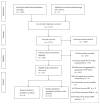Health Risk Behaviour among Adolescents Living with HIV in Sub-Saharan Africa: A Systematic Review and Meta-Analysis
- PMID: 29789804
- PMCID: PMC5896333
- DOI: 10.1155/2018/7375831
Health Risk Behaviour among Adolescents Living with HIV in Sub-Saharan Africa: A Systematic Review and Meta-Analysis
Abstract
The burden of health risk behaviour (HRB) among adolescents living with HIV (ALWHIV) in sub-Saharan Africa (SSA) is currently unknown. A systematic search for publications on HRB among ALWHIV in SSA was conducted in PubMed, Embase, PsycINFO, and Applied Social Sciences Index and Abstracts databases. Results were summarized following PRISMA guidelines for systematic reviews and meta-analyses. Heterogeneity was assessed by the DerSimonian and Laird method and the pooled estimates were computed. Prevalence of current condom nonuse behaviour was at 59.8% (95% CI: 47.9-71.3%), risky sexual partnerships at 32.9% (95% CI: 15.4-53.2%), transactional sex at 20.1% (95% CI: 9.2-33.8%), and the experience of sexual violence at 21.4% (95% CI: 16.3-27.0%) among ALWHIV. From this meta-analysis, we did not find statistically significant differences in pooled estimates of HRB prevalence between ALWHIV and HIV uninfected adolescents. However, there was mixed evidence on the occurrence of alcohol and drug use behaviour. Overall, we found that research on HRB among ALWHIV tends to focus on behaviour specific to sexual risk. With such a high burden of HRB for the individuals as well as society, these findings highlight an unmet need for age-appropriate interventions to address the behavioural needs of these adolescents.
Figures





References
-
- The Joint United Nations Programme on HIV and AIDS (UNAIDS), "The Gap Report," 2014, http://www.unaids.org/en/resources/documents/2014/20140716_UNAIDS_gap_re....
-
- Center for Disease Control and Prevention (CDC), "Adolescent and School Health," 2015, http://www.cdc.gov/healthyyouth/data/yrbs/overview.htm.
-
- Currie C., Zanotti C., Morgan A. WHO Regional Office for Europe; 2012. Health Behaviour in School-aged Children (HBSC) study: international report from the 2009/2010 survey. http://www.euro.who.int/__data/assets/pdf_file/0003/163857/Social-determ....
Publication types
MeSH terms
Grants and funding
LinkOut - more resources
Full Text Sources
Other Literature Sources
Medical
Research Materials

